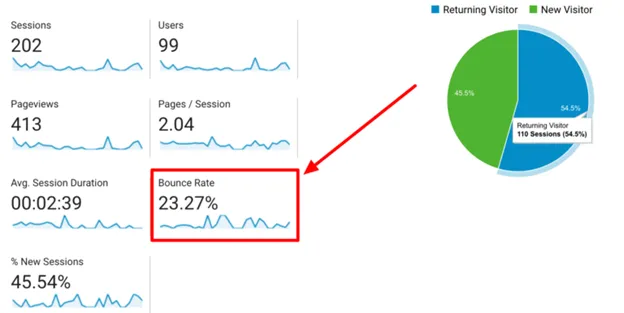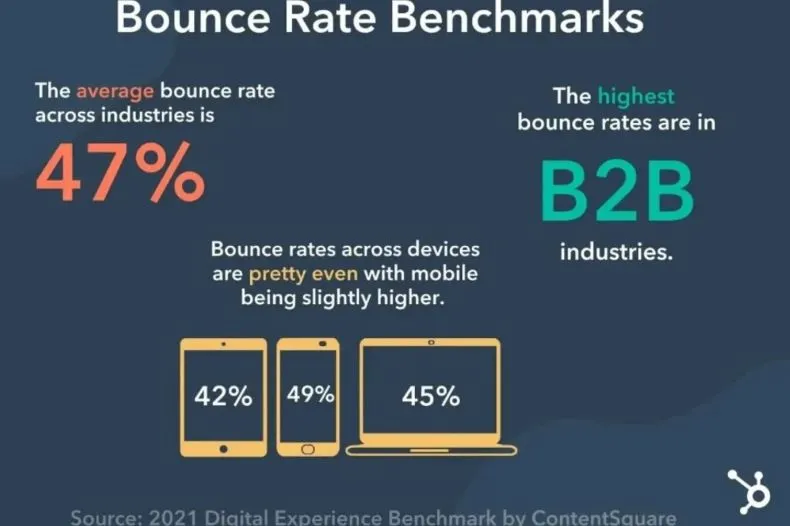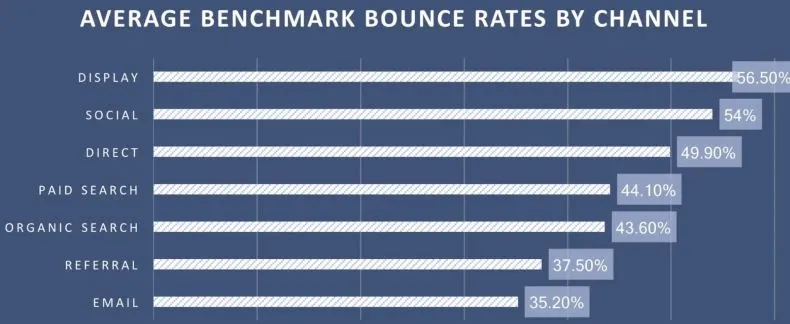The answer to the question: What is bounce rate? Seems quite simple, and we will provide it in this article.
However, the matter gets a little complicated when we try to optimize an objective website bounce rate through measures aimed at improving User Experience.
The more so that the actual bounce rate, average bounce rate, and high bounce rate are still concepts that give rise to further questions.
They raise doubts and involve the need for more insight into all the circumstances.
Another question: How to reduce the bounce rate? Is still too rarely asked in the context of user experience. And yet the majority of reasons pushing the user towards unwanted activities originate from poor UX.
So how to optimize a website for User Experience and simultaneously reduce the Bounce Rate?
How are the Bounce Rate and User Experience connected, and how can we use these links to our advantage?
And more importantly…
Actually, why should we be concerned with the bounce rate? What should the value of the bounce rate be to consider our optimization activities satisfactory, good, and very good?
How to reduce the bounce rate? What does a low bounce rate mean?
Should we fear a high bounce rate? What is the optimum value of the bounce rate?
OK, that's enough questions. Time for some answers.
Even the best question will not make the bounce rate any better.
However, good answers are the perfect starting point for optimization activities that, as you'll see in a moment, are simply necessary.
Enjoy reading!
What is a bounce rate?
Let us start a little from the end. But this is necessary to fully understand the significance of the bounce rate, user engagement, and the relationship between page loading speed and bounce rate.
If you remember our article "Designing good first impression," you might also remember the important issue discussed in it, namely the good first impression effect.
In short, we instantly, in less than 50 milliseconds, evaluate a website or a mobile application for its being:
- Visually attractive (which also affects the high level of the entire website and specific subpages Bounce Rate)
- Compliant with a known standard
- Typical/original
- Adequate/inadequate for the goals we want to achieve, tasks we want to perform, and services we want to use through it
- Credible
- In line with our notions and expectations
- Friendly and emotionally attractive (e.g., whether we like or dislike it).
A lot is happening in our heads in a very short time, not necessarily consciously. And not necessarily based on reasonable premises or solid arguments.
And you better believe that the percentage of users who evaluate website content or an individual page in a given category that fast is very high. In fact, this is how we all function.
What is even more significant, these automatic, subconscious reactions often result in a behavior that is clearly unfavorable to the owners of a given digital business.
Frequently, the customers and users leave a website without giving it another chance, are not interested, do not have a sense of loss, or feel something like FOMO (Fear of Missing Out).
In the world of digital products, FOMO probably does not exist. But there is the Certainty of Finding a Better Option or COFABO.
With COFABO at the back of their minds, Internet users do not explore the resources of a website that made a bad impression.
They simply close a tab or a window, click the Back button, enter a new URL in the browser, exit the browser, or open a new tab and start a new search.
And here, we come to the definition of the bounce rate, which is usually defined as the percentage of visitors who enter the site and then leave it after viewing a single page.
As with most web traffic analysis coefficients, calculating Bounce Rate is not complicated.
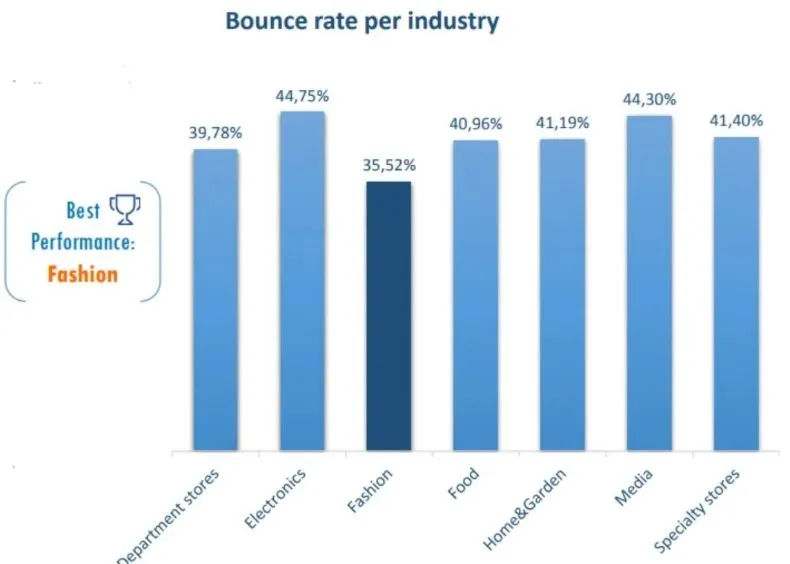
To calculate the bounce rate, you must divide the number of single-page sessions by the total number of sessions and multiply it by 100 to obtain the percentage.
For example, a Bounce Rate of 20% means that 20 out of 100 users left a given website after viewing a single subpage.
However, it is worth quoting an important clarification that appears in the article "Bounces and bounce rate in Google Analytics," posted on the Hotjar blog.
A single-page session happens when a user lands on a website (e.g., a homepage) and exits without triggering another request to the Google Analytics server.
"Another request" could include navigating to other subpages or, e.g., clicking on a call to action (CTA) to enter a sales funnel.
You also need to remember that Bounce Rate can refer to and be measured for:
- Entire website
- Individual page.
In the latter case, the bounce rate is calculated by dividing the number of single-page sessions that begin and end on a particular page by the number of total sessions that start and continue from that same page.
And by analogy, to obtain the percentage, we must multiply the result by 100.
The Bounce Rate may seem insignificant at first. After all, mistakes are made, people have different reasons for leaving a page, and nobody counts the number of customers leaving a brick-and-mortar store immediately after entering it. But in fact, it is quite significant.
First of all, tracking, analyzing, and recognizing the trends in the Bounce Rate allows you to:
- Notice the user behavior on individual pages
- Make better design, business, and marketing decisions
- Allocate resources more accurately.
Furthermore, the Bounce Rate allows you to spot problems related to one, several, or all of the following issues:
- User Experience
- Usability
- Attractiveness and accessibility
- Page effectiveness and performance (e.g., the loading speed of entire content or individual elements).
OK, now we know what the Bounce Rate is and its significance. We understand that ignoring this issue is very unfavorable or rather harmful.
So you could ask: When does the problem start? What Bounce Rate value is problematic and requires corrective action?
What is a good bounce rate?
Obviously, you can never eliminate common human errors, random incidents (e.g., loss of coverage or lack of time to continue a session), technical problems on the user or server side, etc. They are a permanent feature of digital businesses.
So when does the problem start? What level of the Bounce Rate should be worrying?
Are there any objective standards that indicate an acceptable, normal, poor, or critical Bounce Rate?
Determining the problematic nature of the Bounce Rate (e.g., whether a Bounce Rate of 7% gives reason to a serious concern or you should really be worried when it doubles or triples) is relative.
The negative impact of the Bounce Rate is not only a matter of percentage but also other factors, including:
- Website structure, complexity, and volume
- Website goals (user)
- Website goals (business owner)
- Bounce Rate calculation time interval
- Market situation
- Technological developments and new digital product usage patterns (both negative, e.g., technical debt, and positive, although resulting in a high Bounce Rate, e.g., a technological innovation not yet popularized)
- Changes in the user structure
- Stability of the Bounce Rate level
- Website category: the average results will be completely different for e-commerce, an expert website, and a blog
- Advertising campaign quality, if the main sources of the website traffic are the activities of this type
- Page loading speed and the context in which this technical issue is extremely important
- Typical usage patterns of a specific page type (homepages and product pages are used differently)
- Quality of navigation
- Source of traffic (e.g., organic traffic originating in social networks, paid searches, advertising and affiliate networks, content subscriptions, etc.)
- Starting point: traditionally and statistically, homepages have a lower Bounce Rate than, e.g., contact pages.
When analyzing the negative impact of the Bounce Rate, you should remember that there must be a confirmed relationship between a high Bounce Rate and user frustration and dissatisfaction, sales results, user loyalty, user, subscriber, and customer loss, etc.
An apparent connection is always a hypothesis that should be confirmed or refuted.
A high Bounce Rate does not necessarily mean and does not always result in negative user feelings, ratings, and attitudes.
The Bounce Rate does not take into account the time spent on a page. This means that a user could have achieved their goals, and the lack of deeper exploration did not result from its inadequacy or frustrating nature.
It is also worth remembering the reservations about the Bounce Rate voiced in the article "Bounces and bounce rate in Google Analytics," cited earlier.
Its author rightly pointed out that Bounce Rate has one but quite a significant drawback. It does not explain why the users "bounce."
And this, in turn, translates into doubts that can take the form of the following questions:
- What was the bounce reason?
- What happened before the bounce?
- Was the bounce motivated by the website quality or external factors not related to the website or its functioning
- With what emotions, assessments, and attitudes do the users leave the website?
Well, it all depends…
We all know that. This also applies to the Bounce Rate.
For example, a Bounce Rate of 0% is not good at all. Usually, it means that the counting system does not count the traffic.
Suppose you believe it is possible to extrapolate the averages from a small number of sites to the entire class of websites. In that case, you can assume from the results published in the article "What's the Average Bounce Rate for a Website?" that a good bounce rate will be between 40 to 55 percent.
A more reasonable and reliable method is establishing your own standards that will be a reference point and determine the scope of activities.
A suggested solution could be to divide the bounce rate into:
- Critically Low Bounce Rate - suggests tool problems and the need for diagnostics and maintenance
- Moderately High Bounce Rate - average, acceptable, not rising concerns, and not requiring immediate actions
- High Bounce Rate - requires optimization in the short term
- Critically High Bounce Rate - requires immediate optimization.
The values attributable to each range will differ for every business or website.
When defining the ranges, you should take into account the following variables:
- Duration of the data collection: assume a duration enabling you to notice the repeatability or specific trends
- Constant source of traffic: eliminate all variables interfering with the relevance of the measurement (e.g., advertising campaigns, promotional activities)
- Website not changing as regards technology, design, content, and functionalities
- Impact of the Bounce Rate level on sales, business, and market results that should be monitored together with the bounce rate using appropriate metrics.
In other words, we must have at least a minimum level of certainty that the bounce rate values are governed by certain regularities and that there is a repetitive pattern or at least a correlation between the Bounce Rate and other KPIs (Key Performance Indicators).
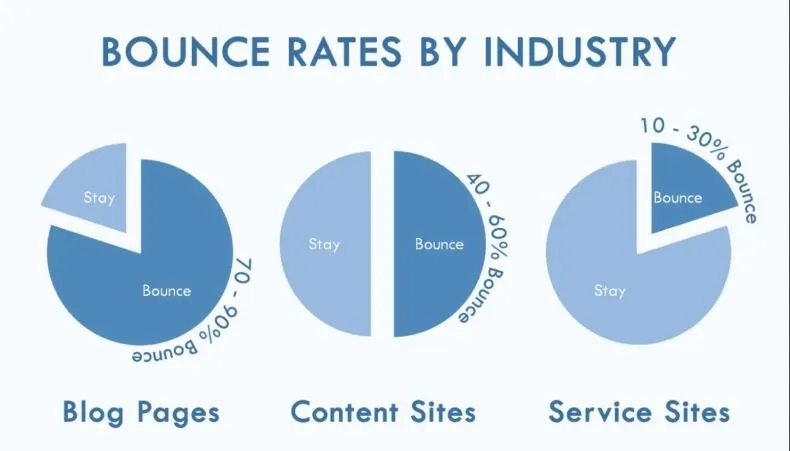
The repeatability of causes and effects will allow you to determine ranges that trigger a procedure, a script of optimization, repair, and diagnostic activities.
It is also worth remembering that the bounce rate, like almost any social phenomenon, takes the distribution of values compatible with the Gaussian distribution in the long term.
Extreme values are the least frequent, while the mean values are the core of the distribution.
How to improve the Bounce Rate through User Experience activities?
The bounce rate is a metric particularly sensitive to technological, design, and content modifications related to the source of the traffic and user experience.
For technological issues, check whether the website:
- Employs up-to-date technology
- Meets all network standards
- Meets the specific search engine and browser standards
- Complies with the current security standards
- Complies with the current accessibility standards
- Complies with the current SEO standards.
For design issues related to the design of user experience, interfaces, and navigation, check (through tests and UX research) whether the website:
- Is useful for the users
- Offers positive User Experience in line with the expectations, needs, and experience
- Provides, among others, appropriate Readability (of larger text blocks), Legibility (of individual characters), and Scannability
- Offers primary and secondary navigation and visually differentiated (e.g., verbal, iconic, symbolic, and graphic)
- Is compatible with the user's mental models in terms of functionality and content.
For website content-related issues, check whether the website:
- Offers relevant content, information, and data that is useful to and expected by the user solves their problems, and fits into their structure of needs
- Offers up-to-date content
- Offers information in a manner and form that is convenient and intuitive and contributes to its finding, understanding, and use
- Offers content that is visually, emotionally, and cognitively accessible.
In addition, when optimizing a website for User Experience, it is extremely important to take into account the issues related to the following:
- Page loading speed: sites should meet the Google Page Experience standards that consider it a very important indicator of website quality and its friendliness in terms of User Experience (more about this issue can be found in the article "Google Algorithm introduces Page Experience")
- Attractiveness and the use of engaging content (e.g., animation, graphics, photos, movie clips, and interactive elements)
- Website consistency and adequacy
- Conscious use of space, shapes, and forms and creating distinct visual hierarchies, contrasts, and visual balance
- Website responsiveness and adapting it to the requirements of various devices, channels, screen diagonals, and resolutions.
A User Experience- and Bounce Rate-optimized website is a website with an identified goal and possibilities of its achievement.
Therefore, the basic set of tools offered should include the following functionalities:
- Searching
- Sorting
- Filtering
- Required form fields that are always problematic in interaction cause a lot of trouble to the website users and make the bounce an obvious choice
- Fast and effortless navigation.
We have started with the issue of the good first impression. It is closely tied to the issues of website credibility and level of trust.
We covered these issues in more detail in the article "B2B website credibility."
In his article "Improving Your User Experience to Reduce Bounce Rates," C.R. Venkatesh refers to extensive research of 2020, whose results suggest that website user experience is the most important factor that allows you to reduce the Bounce Rate.
One of the techniques for increasing website user engagement and simultaneously reducing the bounce rate is to have properly designed Calls to Action.
Their location, wording, and instructional character (pointing to goals, directions, profits, tasks, phases, etc.) enable you to:
- Support the website user navigation
- Support the user's choices
- Provide motivation
- Provide justification
- Define the stakes (how much can the user gain)
- Guide searches
- Indicate content
- Suggest benefits.
The factors, functionalities, and activities that raise the risk of the bounce rate increasing also include:
- Pop-ups
- Automatic startup of audio and audio-visual content
- Aggressively forced need to register
- Deliberate obstacles in reaching the crucial information: contact details and hotline
- Dark pattern - design patterns that benefit business owners and are to the user's disadvantage (e.g., automatically renewed subscription in applications).
We covered these issues in more detail in the article "What do the E-Commerce customers dislike about online stores?."
How to reduce the Bounce Rate? Summary
- The Bounce Rate is defined as the percentage of website visitors who leave it after viewing a single page.
- The Bounce Rate is calculated by dividing the number of single-page sessions by the total number of sessions and multiplying it by 100.
- The Bounce Rate can be calculated for the entire website or an individual page.
- It is not possible to determine a poor bounce rate objectively. There are no standards that indicate a harmful bounce rate when exceeded.
- When you create standards and ranges for the bounce rate on your own, you must have at least a minimum level of certainty that the bounce rate values are governed by certain regularities.
- When creating your own standards defining the impact of the Bounce Rate on the business, you need to be sure that there is a repetitive impact or at least a correlation between the Bounce Rate and other KPIs (Key Performance Indicators).
- A User Experience- and Bounce Rate-optimized website is a website with an identified goal and possibilities of its achievement.
- Website user experience is the most important factor enabling you to reduce the Bounce Rate.
- A high Bounce Rate means something slightly different for each website. You cannot arbitrarily define a high bounce rate.
- The Bounce Rate is not a horse. You don't know it when you see one. It must be explored, defined, and described individually. If you want to keep your website visitors, that is.
- A webpage user knows perfectly well that the website behavior must correspond to their needs (e.g., loading time is vital), and this expectation is triggered within 50 milliseconds. Remember that!


